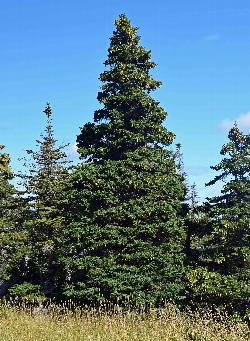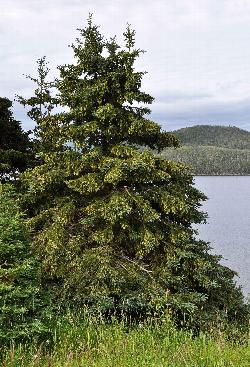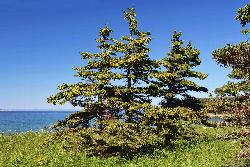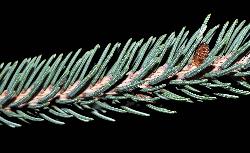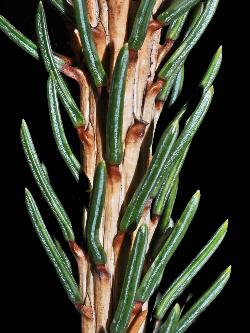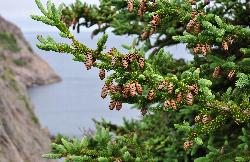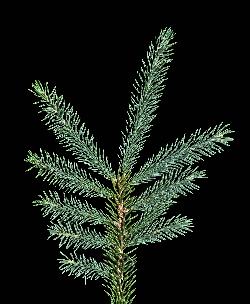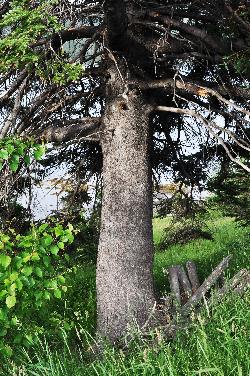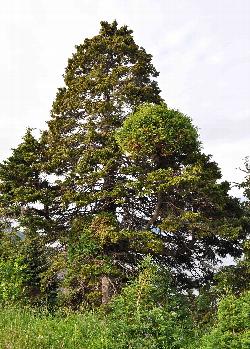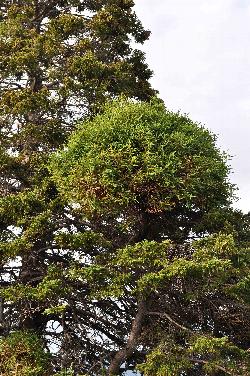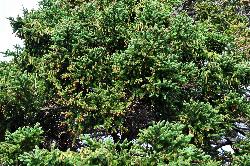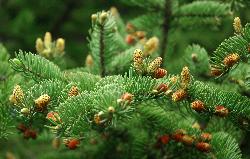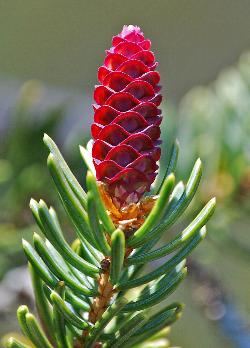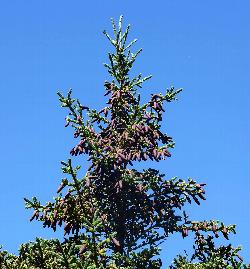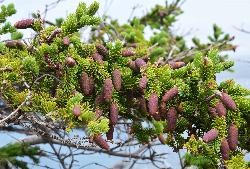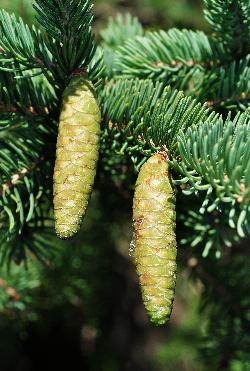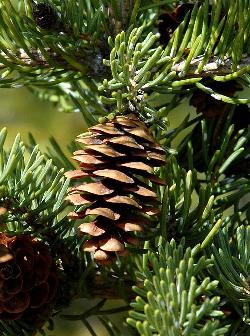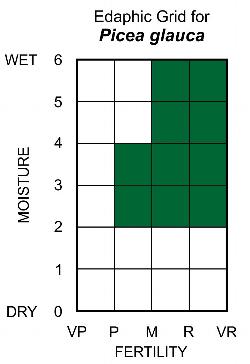Fr: épinette blanche, épinette glauque, épicéa blanc, sapin blanc
IA: minaiku, minaiku-uskhuetui (cone)
IU: napâttutuinnak,kimminguak (cones)
Pinaceae - Pine Family
Picea glauca (Moench) Voss
En: white spruce, cat spruce, Labrador spruce, skunk spruce, Porsild spruce
Fr: épinette blanche, épinette glauque, épicéa blanc, sapin blanc
IA: minaiku, minaiku-uskhuetui (cone)
Pinaceae (Pine Family)
Note: Numbers provided in square brackets in the text refer to the image presented above; image numbers are displayed to the lower left of each image.
General: A medium-sized to tall evergreen tree, to 25 m tall and 60 cm d.b.h., living to about 200 years (Farrar 1995); white spruce usually has a graceful conical profile [1–2], broader than that of black spruce, and the crown is often irregular [3]. In exposed headlands and barrens, it often forms krummholz or prostrate mats due to frost-pruning by high winter winds and ice crystals, which kill the growing buds [4–7]. White spruce is a shallow-rooted species, somewhat susceptible to windthrow, and of intermediate shade-tolerance. Commercially, white spruce is used for pulpwood and lumber (Nienstaedt and Zasada 1990). While white spruce provides cover for a number of mammal species in forest stands, its foliage is seldom consumed by animals; but squirrels and birds do eat the seeds. The common names cat, skunk, and cat-piss spruce refer to the odour of the broken needles, which smell like cat’s urine; thus, white spruce is undesirable for use as a Christmas tree.
Key Features:
- Twigs of white spruce are glabrous and often glaucous [8].
- Needles are 4-angled in cross-section, stiff, with a whitish band of small stomates along each side of the needle [9], spirally arranged, and have an unpleasant odour when crushed.
- Needles narrow to small persistent peg-like bases (sterigmata), which remain attached to the twig after the needles fall [9]; sterigmata are found on the twigs of all spruce species.
- White spruce cones are cylindrical, usually 2.5–6 cm long, occasionally to 11 cm long, and dehiscent after seeds are shed [10].
Stems/twigs: Branching is alternate [11] and young twigs are pale greenish-white, glabrous, and glaucous [8]; older twigs are pale brown and glabrous [9]. The ovate blunt buds are reddish brown, glabrous, and 3–6 mm long, with many overlapping rows of thin bud scales. The bark is greyish-brown and scaly [12–14].
The parasitic eastern dwarf mistletoe (Arceuthobium pusillum Peck), which causes witches' brooms – an abnormally dense growth of short deformed branches, affects primarily black spruce on the Island, but both white and black spruce are listed as primary host species (Hawksworth and Wiens 1972). In Newfoundland, most witches' brooms in white spruce are caused by an infection of yellow broom rust (Melampsorella caryophyllacearum J. Schröt.), with chickweed (Cerastium) species serving as the alternate host (Anonymous 2015). However, a particularly good specimen of white spruce with a large witches' broom caused by eastern dwarf mistletoe was observed in Woody Point, western Newfoundland [15–16].
Needles: Evergreen, simple, stalked, and spirally arranged [8]. Needles are slender, stiff, 1.5-2.5 cm long, green to bluish-green, glabrous, often glaucous, and 4-angled in cross-section with a distinct white line along each side, formed by parallel rows of small white dot-like stomates [17–18]. The tips of the needles are stiff and pointed (acute) to sharply pointed (acuminate). Needles narrow abruptly at the base to woody peg-like attachments (sterigmata), which are decurrent along the stem [9].
Reproductive structures/cones: Unisexual; trees monoecious, with separate male and female cones borne on the same tree [19]. Male cones are ovoid, reddish to yellow, clustered near the tips of 1-year-old branches, and turn brown after pollen is shed [20–21]; pollination is by wind (anemophily). Female cones are cylindrical, 2.5–6 cm long, terminal, and erect when the bud scales are open to receive pollen [22–23]. Immature seed cones (conelets) are reddish-purple, but become greenish-yellow and finally brown at maturity [24–27]. Trees are often heavily laden with cones in mast years [28]. Mature seed cones can measure up to 11 cm long and are pendant at the branch tips [29–31].
Cone scales are obovate with rounded margins and are open during pollination, but close tightly after pollination until the seeds reach maturity in late summer or fall. The winged seeds, 2–4 mm long with a 4–8 mm long wing, are shed throughout the fall and winter; seed dispersal is by wind (anemochory). Cones are deciduous, usually dropping within one year after the seeds are released.
Ecology and Habitat: White spruce occurs throughout the forests of Newfoundland and Labrador, but it is rarely dominant. It has a distinct preference for nutrient-rich, moist upland soils and seasonally inundated alluvium. The largest and fastest growing white spruce occur on open floodplains forests. It also dominates the coastal fringe because of its tolerance to salt spray and the associated nutrient loading. On the lee side of headlands, it displays good growth and form, but on the windward side it is often stunted and even prostrate on cliff edges; it also grows as a stunted krummholz form in exposed barrens. White spruce is most frequently associated with balsam fir and white birch on undisturbed sites. It is not fire-adapted and rarely reproduces by vegetative branch layers. Therefore, it is rarely associated with black spruce except in wet, nutrient-rich habitats. Throughout its range, white spruce is probably the most important tree associated with the invasion of abandoned farmland, often referred to as "old field succession."
Edaphic Grid: See image [32]: the Edaphic Grid for Picea glauca.
Forest Types: White spruce is most common and vigorous in the following vegetation types:
- Abietum dryopteretosum (Dryopteris-Balsam Fir Forest Subassociation)
- Abietum rubetosum (Rubus-Balsam Fir Forest Subassociation)
- Aceretum galietosum (Galium-Mountain Maple Thicket Subassociation)
- Alnetum lycopodietosum (Lycopodium-Alder Swamp Subassociation)
- dryopteretosum (Dryopteris-White Birch Forest Subassociation)
- Betuletum rubetosum (Rubus-White Birch Forest Subassociation)
Wilton (1965) observed that white spruce constitutes less than 5% of the Labrador forest, occurring most frequently in the Fir-Spruce-Birch/Rich Herb Forest Type, where it displays superior growth to other tree species. Similarly, Foster (1984) has white spruce present only in his Birch Forest and Fir-Spruce-Feathermoss Forest communities occurring on nutrient-rich, moist sites. Hustich (1954) reported the occurrence of White Spruce-Lichen Heaths in the Labrador City (formerly Knob Lake) area, which he attributed to the local occurrence of sedimentary bedrock composed of dolomites and shales.
Succession: White spruce is a common associate of balsam fir in the zonal, upland balsam fir-white birch forests and only rarely forms pure stands. Because it sheds seeds annually, it is rarely a component of black spruce stands originating from fire. White spruce can also occur on river floodplains, where it receives nutrition through annual siltation. Moose browsing of balsam fir regeneration can cause localized conversion to white spruce cover. White spruce is generally shallow-rooted, but blowdown has rarely been observed in Newfoundland except on floodplains; decadent trees may snap at several meters above the root collar.
Distribution: White spruce is a transcontinental boreal species that occurs throughout Newfoundland and Labrador, usually in low abundance. It appears to extend further north than black spruce on the Labrador Peninsula (Wilton 1965). This trend is repeated throughout most of eastern Canada, but through western Ontario and northern Manitoba, it is the dominant tree in lichen woodlands on drumlins and eskers. Further west, in Alberta and north into the Northwest and Yukon Territories, white spruce overtakes black spruce as the dominant upland tree species on richer soils derived from Ordovician-Silurian and middle Devonian bedrock; it also occurs along the forest/prairie interface in the western Provinces. White spruce is a cold-hardy species that occurs further north than black spruce into the treeline and Alaska. Its southern distribution includes Maine, New Hampshire, Vermont, and northern portions of the Lake States.
Similar Species: Black spruce (Picea mariana (Mill.) B.S.P.) is a tall evergreen tree with drooping branches; it often reproduces vegetatively by layering (rooting of branches on the ground). Like all spruce, black spruce has stiff pointed 4-angled needles, but the twigs of black spruce bear short brown hairs and small glandular hairs, visible with a hand lens. The semi-serotinous seed cones of black spruce are ovoid, 2–3 cm long, and remain in the club-shaped crown of the tree for many years. Black spruce seeds are released by fire or extreme heat and require bare mineral soil to germinate. Black spruce prefers wet, poorly-drained organic soils and is frequently found in and around bogs and swamps; it also grows in shallow soils on nutrient-poor sites. Red spruce (Picea rubens Sarg.), an upland to subalpine maritime species, is restricted in range in Newfoundland to a small area north of Bay D'Espoir; its twigs are sparsely to densely pubescent with white, non-glandular hairs.


